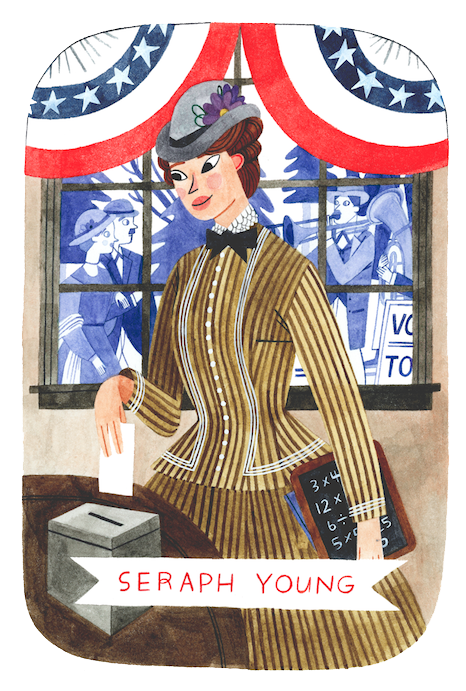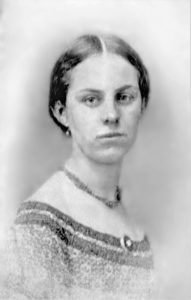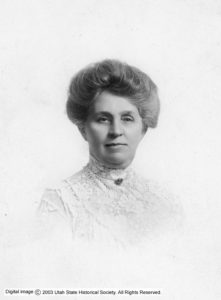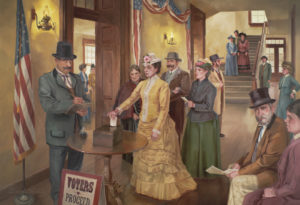
Additional Resources
Seraph Young Ford,
First Woman to Vote with Equal Suffrage
1846–1938
First Woman to Vote with Equal Suffrage
by Rebekah Clark
Historical Director, Better Days

Seraph Young. Deseret News.
On Valentine’s Day in 1870, Seraph Young arrived early at the polls in Salt Lake City on her way to work as a schoolteacher. Amid stump speeches and music from the LDS Tenth Ward brass band, she entered City Hall, cast her ballot in the municipal election, and made history as the first woman in the United States to vote under a women’s equal suffrage law.
Seraph’s historic vote made Utah the first place in the modern nation in which women exercised the same suffrage rights as men. Although Wyoming Territory merits distinction as the first to extend voting right to women in December 1869, Utah Territory quickly followed and extended suffrage to its much larger female population on February 12, 1870. Just two days after the passage of the women’s suffrage bill, Salt Lake City held a local election that provided Utah’s newly-enfranchised women an almost-immediate opportunity to exercise their expanded political rights. And on August 1, thousands of women voted in Utah’s general election. The small population of Wyoming women did not have an opportunity to cast votes until September 1870.
Seraph Young’s being one of the few to participate in that first Utah election indicates her personal enthusiasm for women’s suffrage and interest in political matters. And as a twenty-three-year-old schoolteacher at the University of Deseret model school, she likely voted early in the day because she had to get to work!

Seraph Young Ford. Photo courtesy of Utah State Historical Society.
The election of February 14, 1870, was also the first election in Utah Territory that included opposing political parties, with the formation of the Liberal Party and the People’s Party just days before the election. This made Utah women’s participation in elections all the more significant. Though only twenty-five women reportedly cast votes in February 1870, six months later a few thousand women voted in the general territorial election. Seraph Young’s being one of the few to participate in that first election indicates her personal enthusiasm for women’s suffrage and interest in political matters.
Despite the historical significance of her vote that day, little is known of Seraph’s personal life. She was a grand-niece of LDS Church president and former Utah governor Brigham Young. Born on November 6, 1846, at Winter Quarters, Nebraska Territory, to Brigham Hamilton Young and Cedenia Clark, she traveled to Utah as an infant in October 1847.
As we wrote in this blog post, two years after casting her momentous vote, Seraph married Seth L. Ford on February 11, 1872. Seth was a printer from New York and a Civil War veteran. The Fords had three children in Utah: Fried died as a toddler, but Grace and Cherry survived to adulthood. The family moved to New York in the late 1870s, perhaps to be near Seth’s family as he suffered from major health challenges due to the effects of his wartime service. Seth began receiving a pension for veteran invalids due to “blindness and spinal disease,” and he temporarily lived in a home for disabled veterans from 1882 to 1884.[1]
Somehow, Seraph found a way to care for her blind and paralyzed husband for nearly three decades while managing a household on his small pension. One newspaper reported that “her unselfish devotion is well known by all her friends.”[2] But there weren’t many options available for a married woman to support her family. A record in the National Archives Civil War Pension Files shows that the whole family including Grace and Cherry sometimes performed on the streets, singing and playing the banjo and harmonica, to earn coins from passers-by. [3]
The Fords eventually moved to Baltimore and later Montgomery County, Maryland, just outside Washington, D.C., to be near their two adult daughters. Seraph’s devotion to family extended to adopting her ten-year-old granddaughter, Helen Lawrence, after her daughter Grace divorced and remarried.[4]
Seraph was never able to return to Utah because of her husband’s need for constant care, but she reconnected with friends and family from home whenever they visited the nation’s capital. Emmeline B. Wells once noted in her diary that Seraph had accompanied her to meet with officials from the National Council of Women during their 1895 convention. Although the circumstances of Seraph’s life didn’t allow for much public engagement, she still clearly retained her interest in political affairs.
Like many women, Seraph’s financial struggles worsened after her husband passed away in 1910. She had previously sold off land to make ends meet, so she lived in a rented house with her daughter at the end of her life. After her death in 1938, Seraph was buried next to her husband in Arlington National Cemetery. Her name was spelled wrong on the headstone for decades, but we worked to get that changed and Seraph was honored at a small ceremony with her descendants and Utah leaders on September 29, 2020.
Hopefully someday women will leave their “I Voted” stickers at Seraph’s headstone to honor her legacy as an ordinary woman who made history!

Today, a large mural depicting Seraph Young casting her historic ballot adorns the north House Chamber of the Utah State Capitol building. The mural, painted by David Koch, memorializes both Seraph and Utah’s contribution and commitment to the cause of women’s suffrage. She’s also included in a memorial to women’s voting rights, titled A Path Forward, at Salt Lake City’s Council Hall where she cast her first ballot.
Rebekah Clark holds a law degree from J. Reuben Clark Law School and a bachelor’s degree in American History and Literature from Harvard University, where she wrote her honors thesis on Utah’s participation in the national women’s suffrage movement. She’s the Historical Director of Better Days and a member of the Mormon Women’s History Initiative Team.
[1] General Register of Inmates Admitted to The New York State Soldiers’ and Sailors’ Home, National Archives, Historical Register of National Homes for Disabled Volunteer Soldiers, 1866-1938; Available at Ancestry.com.
[2] “Salt Lakers in Gotham,” Deseret Evening News, 15 March 1902, p. 10.
[3] The record was transcribed here by our board member Ron Fox.
[4] “Would Adopt Child,” Washington Times, December 23, 1904.

